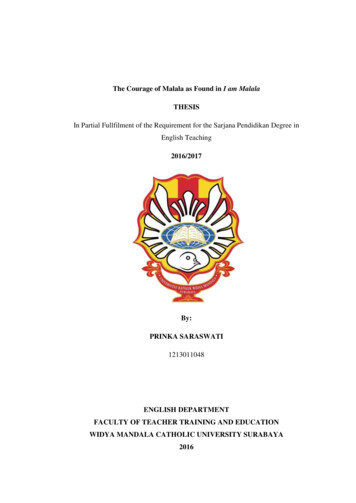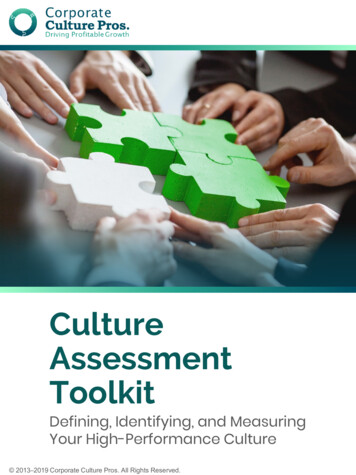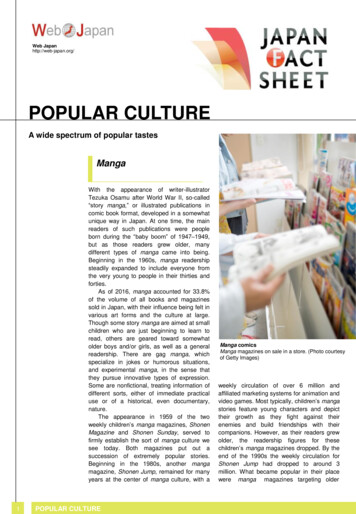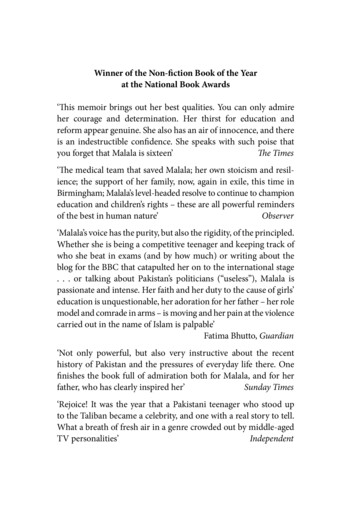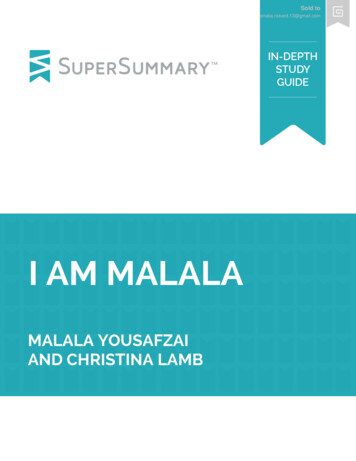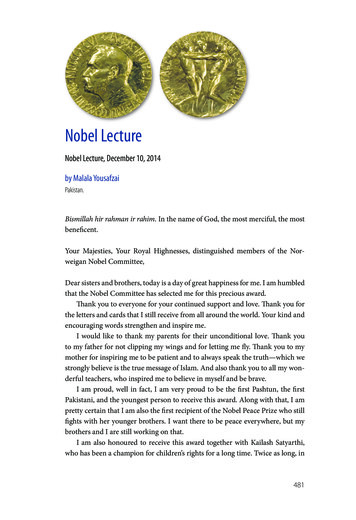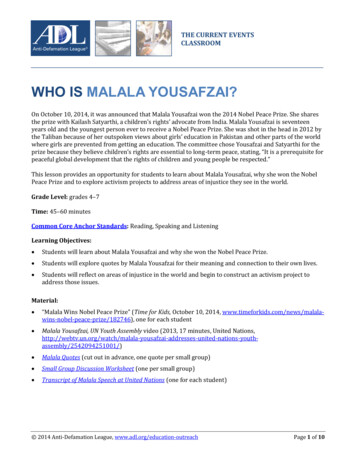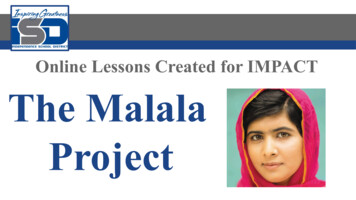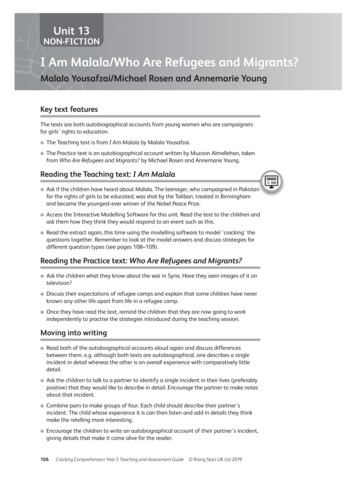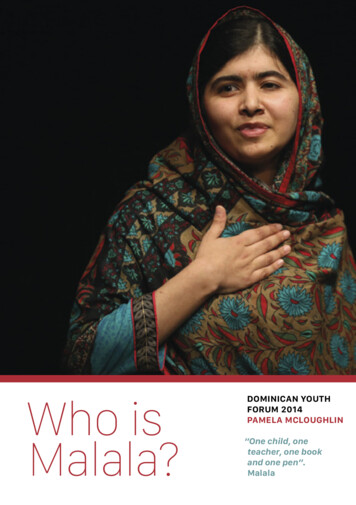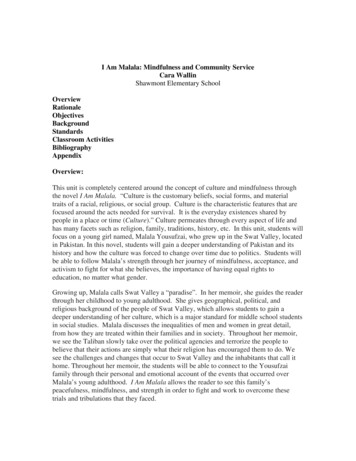
Transcription
I Am Malala: Mindfulness and Community ServiceCara WallinShawmont Elementary dsClassroom ActivitiesBibliographyAppendixOverview:This unit is completely centered around the concept of culture and mindfulness throughthe novel I Am Malala. “Culture is the customary beliefs, social forms, and materialtraits of a racial, religious, or social group. Culture is the characteristic features that arefocused around the acts needed for survival. It is the everyday existences shared bypeople in a place or time (Culture).” Culture permeates through every aspect of life andhas many facets such as religion, family, traditions, history, etc. In this unit, students willfocus on a young girl named, Malala Yousufzai, who grew up in the Swat Valley, locatedin Pakistan. In this novel, students will gain a deeper understanding of Pakistan and itshistory and how the culture was forced to change over time due to politics. Students willbe able to follow Malala’s strength through her journey of mindfulness, acceptance, andactivism to fight for what she believes, the importance of having equal rights toeducation, no matter what gender.Growing up, Malala calls Swat Valley a “paradise”. In her memoir, she guides the readerthrough her childhood to young adulthood. She gives geographical, political, andreligious background of the people of Swat Valley, which allows students to gain adeeper understanding of her culture, which is a major standard for middle school studentsin social studies. Malala discusses the inequalities of men and women in great detail,from how they are treated within their families and in society. Throughout her memoir,we see the Taliban slowly take over the political agencies and terrorize the people tobelieve that their actions are simply what their religion has encouraged them to do. Wesee the challenges and changes that occur to Swat Valley and the inhabitants that call ithome. Throughout her memoir, the students will be able to connect to the Yousufzaifamily through their personal and emotional account of the events that occurred overMalala’s young adulthood. I Am Malala allows the reader to see this family’speacefulness, mindfulness, and strength in order to fight and work to overcome thesetrials and tribulations that they faced.
This unit which I have created is not meant to be a novel study, but are rather culminatingactivities to help students connect and relate to what they have read to everyday lifethrough mindful and community service learning. Students will take a deeper andreflective look into Malala’s fight for education and the reasoning she found it soimportant. Students will then relate acceptance of other cultures through the tool ofeducation.Rationale:In today’s day in age, there is so much hate and blame placed on groups of people,whether by race, religion, sex, etc. As an educator, I believe it is my job to break downthese assumptions and stereotypes that produce such negative outlooks on life andpeople. Education is the key to finding and understanding the truth behind culture.Students need to learn the importance of diverse cultures and how to accept and respectthe differences, as well as acknowledge the similarities.Malala Yousufzai is an exemplary role model of strength, mindfulness, and perseverance.Her journey was no where near easy, but she continues to fight feverously even when theodds have been stacked against her and her life and her family’s life has been threatenedand in danger. Malala has been fighting with peace, not hate. She has found ways toovercome her terror and fear through mindful practices to find her inner peace with thesituations that have arisen in her life.Today, students and young children are faced with so much turmoil and trauma and arenot always given the outlets to explore and heal. They have seen so much hate andvengeance, whether it be in their home, neighborhood, or broadcasted on the news.Reading this novel with middle school students will allow an opportunity for a door toopen. The classroom will serve as a safe and unbiased haven where a conversation canoccur so that students can ask questions or share concerns. Malala’s bravery andunwavering determination to find peace and equality will resound with the students. Thisnovel is an excellent way to introduce tools we can all use to help heal and find our ownpeace.Objectives:This particular unit is aligned with 6th grade standard, but can be used for middle schoolstudents. This sixth grade is an inclusion classroom with 32 students. The students cycleonce in the first half of the day. One sixth grade teacher teaches math and science, whileI teach social studies and literacy. The students have a 45-minute lunch, along with a 45minute rep in the afternoon. (Preps include music, computer, gym, and SAM- SchoolAcademic Music Program).
Students will be able to identify and practice different strategies in order tomanage inner and peer conflict.SWBAT identify the similarities and differences of the culture in America to theculture in Pakistan.SWBAT analyze the inequality of men and women in Pakistan IOT write anargumentative essay.SWBAT research the importance of education IOT comprehend Malala’s fund.Background:Malala YousafzaiI Am MalalaMingora, Pakistan is a beautiful town in what is called Swat Valley. Swat Valley was apeaceful and traditional town before the Taliban, a radical militant islamic group, arrivedand began terrorizing the people of Mingora in 2004. The Taliban’s presence made theirday to day life very different and was difficult for those who inhabited Swat to behappy. Under the regime of the Taliban, girls could no longer receive an education andwere forbidden to attend school. There was one girl who refused to believe her dreamswould be crushed by the Taliban, and that is Malala Yousafzai.Malala Yousafzai was born in Mingora, Pakistan on July 12, 1997. She was the firstchild to Ziauddin Yousafzai and Tor Pekai Yousafzai. In Pakistan, men and women aretreated very differently than here in the United States. Men and women are notconsidered equal. For instance, women are not allowed to leave the house unlessaccompanied by a male, no matter what the age of the male. Births of boys werecelebrated by family coming from all over to meet the newest addition and girls were not,but not Malala.From the moment Malala came into this world, her journey has been different from mostfemales in Mingora. Her parents were head over heals excited to be having a girl andplanned each and every family member to come and greet her, which was not thecommon. Her parents gave her the name Malala after a famous Pashtun poet and warriorfrom Southern Afghanistan, named Malalai of Maiwand. From that day her journey ofstrength and determination began.Malala fell in love with school, where she attended her father’s school. She wouldchoose math questions and poetry over playing and drawing anyday. After the Talibaninfiltrated Swat and attacked schools that taught girls, Malala started her public
appeal. In 2008, she gave a speech in Peshawar, Pakistan which focused on the followingquestion, “How dare the Taliban take away my basic right to education?” (Bio.com)Later in 2009, Malala had gained enough attraction and support throughout variouslocations and it was enough for BBC network to contact her in hope for her to share herstory with the world. Malala began blogging under a pseudonym about how the Talibanwere threatening and denying her human rights to education. Unfortunately, in a veryshort amount of time, her identity was revealed to the public and the Taliban were awareof her outbursts against their rule, which was unacceptable. Even though she and herfamily received many threats, she continued to use the platform that she and her fathercreated to speak out against the indemnities and be an activist for girls rights toeducation. Her voice and opinion opened the door to the nomination for theInternational Children’s Peace Prize and was awarded the National Youth Peace Prize ofPakistan.With all of this positive and popular attention from various groups and locations, theTaliban became very threatened and started issuing death threats on Malala and herfamily. Of course her family became frightened, but found solace in the fact that theTaliban had never killed a child, which is why Malala worried more for her father thanfor herself. Unfortunately, this assumption was proven wrong on October 9, 2012, whena gunman stopped her school bus on the way to school. The gunman asked the girls onthe bus for Malala, and her location was given away instantaneously. The gunman firedthree shots. Two bullets hit two girls sitting on either side of Malala and the third one hitMalala on the left side of her head and traveled down her neck.Malala and the two other girls were immediately taken to a hospital to receive medicalattention. Later, Malala was transferred to a hospital in England for treatment and safety,as the threats for her life were still very real. After months of surgeries and rehabilitation,Malala once again started on her journey of fighting for education. Although she doesnot reside there, due to the imminent threats, she still has a strong passion and desire forequal rights in education across the world.The attempted murder/assassination of Malala resulted in a great deal of media coverageand tons of support for Malala’s fight. On her 16th birthday, Malala was celebrated at theUnited Nations and gave a speech on the importance of education. Malala ends herspeech with a poignant statement, “One child, one teacher, one book, and one pen canchange the world.” This quote has since been her motto for the Malala Fund which shehas created, in order to keep the awareness going in hopes to bring a solution.In October 2014, at the age of 17, Malala Yousafzai received the Nobel Peace Prize,making her the youngest person to receive the Nobel Peace Prize. In congratulatingYousafzai, Pakistani Prime Minister Nawaz Sharif said: “She is (the) pride of Pakistan,she has made her countrymen proud. Her achievement is unparalleled and unequaled.
Girls and boys of the world should take lead from her struggle and commitment." U.N.Secretary-General Ban Ki-moon described her as "a brave and gentle advocate of peacewho through the simple act of going to school became a global teacher.”Malala continues to battle for what she believes is right. She has stated time and timeagain in interviews and in her own memoir, that she does not hate the Taliban and thatshe would not want to cause them harm. She would want to talk to them and help themunderstand. This type of strength and mindfulness is a prime example for students togain a deeper understanding of the “good life”.MindfulnessMindfulness is an array of different ideas and concepts that help with attention andawareness in present moments. “By focusing our attention and controlling our breath, wecan learn to reduce stress and optimize the learning capacity of the brain” (MindUP).Being mindful, includes concepts such as self awareness, self- management, and socialawareness.Meditation is a very common and important practice in mindfulness. Mindfulness is avery simple form of meditation that was little known in the West until recently. One ofthe most common ways to meditate is focusing solely on your breath. When you slowdown each and every breath and pay attention to the moment when the breath flows inthrough your nose and out through your mouth. This form of meditation, focuses on thebreath entering and moving through the body, usually down to your bellybutton. Focusing on each breath in this way allows you to observe your thoughts as theyarise in your mind and, little by little, to let go of struggling with them. When you gothrough this motion and try to focus all of your thoughts on your breath and breath alone,it is easy to realize that thoughts come and go and add a sense of clutter to yourmind. They seem to run through your mind as a never ending list. Practicing this form ofmeditation, you can watch as these lists appear in your mind, seemingly from thin air, andwork and focus to finding ways for them to disappear. These exercises help one take adeeper look into their feelings to better understand them how to cope with them. Mindfulness is about observation without criticism; being compassionate with yourself.When unhappiness or stress hover overhead, rather than taking it all personally, you learnto treat them as if they were black clouds in the sky, and to observe them with friendlycuriosity as they drift past.” In conclusion, mindfulness allows you to catch negativethought patterns before they tip you into a downward spiral. This practice of meditationhelps put you in control of your life, thoughts and emotions.
Mindfulness can help change and create tools and mechanisms that with help promotehappiness and wellbeing throughout a lifetime. Scientific studies have shown thatmindfulness not only prevents depression, but that it also positively affects the brainpatterns underlying day-to-day anxiety, stress, depression and irritability so that whenthey arise, they dissolve away again more easily. Other studies have shown that regularmeditators see their doctors less often and spend fewer days in hospital. Memoryimproves, creativity increases and reaction times become faster (What can it do for you?)Standards:The School District of Philadelphia curriculum is aligned to the Pennsylvania AcademicStandards for science and mathematics. This curriculum unit will include standards fromlanguage arts and health, along with standards from mathematics, which will focus onalgebraic equations and expressions. Students will focus on the many steps on how toexperiment. They will be able to articulate their hypothesis and understand the differenceof an independent variable and dependent variable.5.1.C.C Evaluate the application of the principles and ideals in contemporary civic life. Liberty / Freedom Democracy Justice Equality5.2.C.B Analyze strategies used to resolve conflicts in society and government.5.3.6.H Describe the influence of mass media on society.6.3.W.B Analyze how conflict and cooperation among groups and organizations haveinfluenced the history and development of the world. Ethnicity and Race Working conditions Immigration Military conflict Economic Stability6.4.W.C Compare the role groups and individuals played in the social, political, cultural,and economic development throughout world history.7.3.6.A Describe the human characteristics of places and regions using the followingcriteria: Population Culture Settlement Economic activities Political activities8.1.6.A Explain continuity and change over time using sequential order and context ofevents.
Standard - 8.1.6.B Differentiate between fact and opinion, multiple points of view,and primary and secondary sources to explain historical events.10.3. Safety and Injury PreventionC. Describe strategies to avoid or manage conflict and violence. anger management peer mediation reflective listening negotiationStrategies:This unit will contain age- appropriate activities that will be included cross- curricular inboth social studies and literacy. Lessons will be differentiated to meet IEP learning goalsand reach every student. Students will access a wide variety of sources, including web,text, and videos in order for students to get a deeper understanding of Malala and herculture. Students will complete research and hands-on activities in order to engagestudents and reach the many different type of learners within the classroom. Somestrategies I plan on incorporating are the following:Practicing MindfulnessWithin the four- week unit, students will be introduced to the practice called mindfulness.Mindfulness is focusing and paying attention on the here and now, the present.Mindfulness will help promote an optimistic classroom and help students developmindful attention to oneself and others, tolerance of differences, and the capacity of eachmember in the classroom to grow as a learner. Through the practice of the mindfulness,students will gain insight into their own minds and behaviors as well as those aroundthem. Some examples that will be incorporated in this unit will be the following:becoming aware of the breath, noticing thoughts as they pass the mind, feeling thevarious sensations of emotions, attending to the body at rest and in motion, practicingsending kindness to oneself and others. (About AME)”.JournalingWithin this three- week curriculum unit, students will engage in journaling. At thebeginning of every social studies class, students will be given a symbol or a questionabout electronics. Each journal includes a brief and general description, along withprompts and questions to help guide the students in creating their own thoughts andhypotheses. The students will be given five to ten minutes to write freely in response tothe prompt. This strategy allows students to integrate their prior knowledge, as well asthe knowledge the students have attained in the classroom. Journaling helps documentthe students’ growth throughout the curriculum unit and it will allow students to recordquestions or interesting facts. Setting this activity at the beginning of each lesson ensuresthat the students are reflecting and focusing on the topic at hand, so that they are readyfor the lesson ahead.
Choice BoardsOne of my main objectives as a teacher is to encourage and guide students to becomeindependent learners. Students need to take ownership of their learning process and theactivities they complete. Choice boards are an excellent strategy, which gives thestudents an active role in their learning by giving the student options. For a choice board,the teacher first has to determine the objective. Once the objective and purpose havebeen established, the teacher will choose activities, which help reach the outcome of thedesignated objective. There should be a wide variety of activities that will inspire themany different types of learners within the classroom. The choices will then be visuallyrepresented to the students, whether in words, or by examples. Students will then begiven the direction to choose one, or more than one activity that is engaging to theirneeds. With this strategy, it allows students to choose a project or activity that they areinterested in, which will result in a better product and comprehension.DifferentiationIn a classroom there are many types of learners. Each student comes to class withdifferent cultural backgrounds, academic backgrounds, interests, learning styles, etc. It isimportant to differentiate the content, instruction, and student products in order to ensurethe success of all students. Differentiation is the matching of appropriately challengingcurriculum and instruction with a student’s ability, interests, and learning styles through avariety of activities, strategies, and material (“Differentiation”). In this curriculum unit,all students will be learning the same content, but each student’s needs will be addressedthroughout the unit. Students will show their understanding in a variety of ways that ispersonal to their needs. Lessons will ensure to challenge students through tieredactivities and higher order questioning. With planning, differentiation will help eachchild accelerate as a life- long learner, while reaching the goal of each objective for theunit.Think Pair ShareThe Think-Pair-Share strategy is designed to differentiate instruction by providingstudents time for creating their own thoughts and conclusions about a topic. It allowstime for students to formulate questions or findings that might have. After students weregiven a few minutes to independently think, then they turn to their partner/buddy andshare their thoughts. The partners have a meaningful discussion where they are beingactive learners. “This learning strategy promotes classroom participation by encouraginga high degree of pupil response, rather than using a basic recitation method in which ateacher poses a question and one student offers a response.” (Read Write Think) Havingstudents work with only one partner rather than whole class or group instruction, thestudents have more of a voice. They are heard by their partner and are able to have acontinuous and fluent conversation. Being able to have this personal conversation aboutwhat they are thinking which increases their sense of involvement in classroomlearning. During this time, the teacher is able to circulate around the room, join in onconversations, answer questions, or just observe.
Activities:Activity 1: Introducing Mindfulness/ MeditationTime: 45 minutesMaterials: Journal Activity (Appendix B) Mindful Coloring (Appendix A)Objective: Students will be able to identify and practice different strategies in order tomanage inner and peer conflict.Standard: 10.3. Safety and Injury PreventionC. Describe strategies to avoid or manage conflict and violence. (anger management, peermediation, reflective listening, and negotiation)Procedure:1. Today I want us to learn something called mindfulness. Has anyone ever heardthe word Mindfulness? Mindfulness is noticing what is happening in the presentmoment. Mindfulness can help us learn to pay close attention to many things. Itcan also help us calm down when we are angry, sad, frustrated, or have anydifficult emotion. Mindfulness can help us notice when we are happy or gratefultoo. It can also help us focus and in school, sports or music. We’re going to trypracticing mindfulness everyday so even if we don’t understand exactly what it istoday, we will after some time.2. If students are at their desks, have them all move their chairs away from theirdesks and turn them toward the front of the room. Explain that they can do thiseach time when practicing mindfulness. Remind them each time until it is a habit.(They will be practicing before each activity.)3. The first thing that will help us during mindfulness is to let our bodies be verystill. The second thing automatically happens when we get still, which is beingaware of the noise around us, which we are working towards complete silence.4. Explain that we have still bodies and quiet bodies, which is what we will call ourmindful bodies.5. Now, let’s close our eyes and just sit like that for one minute. Focus on yourbreath entering in your nose and out your mouth. Follow the breath down to yourbelly button and back up to your mouth. Explain to students that we willeventually add counting into this routine. Have students try to focus on this fortwo minutes on the first day. (By the end of this unit, have students work upenough stamina for 10 minutes.)6. After each beginning meditation activity, have students either complete a journalor coloring sheet, in order to help students focus their thoughts and feelings. Asthe teacher, you have the freedom to decide which days would be best for mindfulcoloring and journal writing. Templates for both in the explore-mindful-resources/)
Activity 2: Reaction to Interview with MalalaTime: 45 minutesMaterials: Video: https://www.youtube.com/watch?v gjGL6YY6oMs Computer Worksheet (Appendix C) Breathing Exercise - https://www.youtube.com/watch?v SEfs5TJZ6NkObjective: SWBAT analyze Malala s point of view and reactions to questions abouthistorical events IOT determine her feelings towards each event how she has found innerpeace in her journey.Standard: Standard - 8.1.6.B Differentiate between fact and opinion, multiple points ofview, and primary and secondary sources to explain historical events.10.3. Safety and Injury PreventionC. Describe strategies to avoid or manage conflict and violence. (anger management, peermediation, reflective listening, and negotiation)Procedure:1. Complete a 3- minutes breathing exercise with students.a. Use the following link to coach the exercise:https://www.youtube.com/watch?v SEfs5TJZ6Nk2. Review the events that have happened to Malala based on the memoir we haveread, I Am Malala.3. Have students discuss what point of view the memoir was written in.4. Have students review the questions found on the worksheet, before showing theinterview clip.5. Show the video clip to students.6. Give students time to complete and answer the questions on the worksheet incomplete sentences.7. Review students’ responses. (Allow time for discussion and different points ofview.)Activity 3: Exploring and Understanding the Malala FundTime: 45 minutesMaterials: Computers for groups or individual students Video (He Named Me Malala Extra Footage) Worksheet- Exploring Malala Fund (Appendix D) Meditation music- https://www.youtube.com/watch?v KqecsHPqX6YObjective: Students will be able to explore and navigate the Malala Fund website, inorder to get a better understanding of what the main goal of her organization is.Standard:Procedure:
1. Give students a coloring worksheet from the first lesson. Have students color thissilently, while listening to the meditation music listed above in the materials list.2. Once completed, have a group discussion about how they feel after listening tothe music and coloring independently and in silence.3. Introduce the Malala Fun by showing the Extra Footage on He Named MeMalala.4. Students can then work independently, with a partner or a small group to explorethe website https://www.malala.org/5. Have students answer the questions on the worksheet listed in Appendix D.6. As a class, review the answers to the questions.7. This activity will serve as a good base for the following projects in this unit.Activity 4: Students will create their own fund for a current and important issueTime: 3 classes -45 minutes eachMaterials: Computers Poster Board/ Markers Google Slides/ Power Point Rubric (Appendix E) 5- minute meditation:https://www.youtube.com/watch?v vVaMLYAiR8o&t 13sObjective: Students will be able to research and investigate issues that are in our currentevents in order to raise awareness and a solution to that issue.Standard: 5.2.C.B Analyze strategies used to resolve conflicts in societyand government.5.3.6.H Describe the influence of mass media on society.Procedure:1. Complete 5- minute meditation using the following linkhttps://www.youtube.com/watch?v vVaMLYAiR8o&t 13s2. Review with the students about what they had learned about the Malala Fund.a. Explain that Malala Yousafzai created a fund, the Malala Fund, to helpgirls worldwide get an education. She believes that everyone has the rightto education and she has fought for this issue in her own country, as wellas across the world.3. Have students brainstorm a social issue that they believe requires attention of thepublic. (The issue can be a local, statewide, national, or worldwide matter. Itdoesn’t have to effect everyone, but it should be prevalent enough that people willunderstand the problem.)4. Students will then work with a small group to create a foundation that wouldbring a spotlight on the issue they chose.
5. Students will then have to think of a creative way to bring light to their concept.They will have to find ways to market their foundation by either creating a posterboard or a digital visual aid (It can be hand drawn on a poster board or it could bePower Point/Google Slides presentation).6. The marketing campaign you should include all of the following information:1. What is the name of your foundation?2. What is your goal?3. Who will it benefit?4. Who do you expect to contribute to your fund?5. What would you consider progress for your foundation?6. Who will or should be in charge of this group?7. What will be your slogan?8. With what other organizations might you collaborate?Activity 5: Culminating Community Service Learning ProjectTime: 5 classes – 45 minutes eachMaterials: Laptops (Research and Power Point/ google Slides) Materials will vary for the chosen project Rubric (Appendix F) Choice Board- List of activities to choose from found 0FundraisingIdeas.htmlObjective: Students will be able to collaborate with fellow students in order to create aninnovative way to raise awareness to the Malala Fund across the school, while raisingmoney for this cause.Students will be able to collaborate with a group to create and propose an idea to theirschool/principal in order to help raise money for the Malala Fund, which promotes andsupports education of girls all across the world.Procedure:1. Malala Yousafzai created a fund, the Malala Fund, to help girls worldwide getan education. She believes that everyone has the right to education and she hasfought for this issue in her own country, as well as across the world.2. Have students use laptops to once again review the Malala Fund athttps://www.malala.org/3. Ask students to journal different ways they can bring awareness of this fund toall the students in the school and how we can raise money to donate to thisfund.4. Have a brief class discussion about some of their thoughts, why they think it isso important, and what they think they could do to help raise money for thiscause.5. Have students break up into groups of 2 or more, but no more than 5.
Distribute rubric and guidelines to each student, so that they can follow alongwith the directions as you read them aloud. (See Appendix for Rubric andGuidelines)6. Have students either search online using the es/100FundraisingIdeas.html orprint out this page for students to review and get ideas from.7. Students will have to collaborate with their group to create a fundraiser thatwe can do across the school.8. Students will have to think and make a proposal of how we would roll out thefundraiser, while bring awareness.9. Students will most likely need 3-4 days to figure out all the logistics.10. Students will then have to organize
the novel I Am Malala. “Culture is the customary beliefs, social forms, and material traits of a racial, religious, or social group. Culture is the characteristic features that are focused around the acts nee
